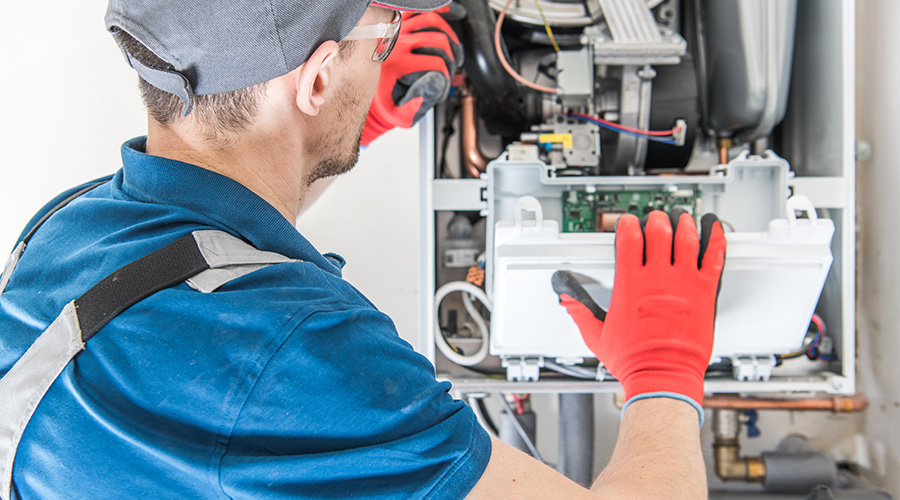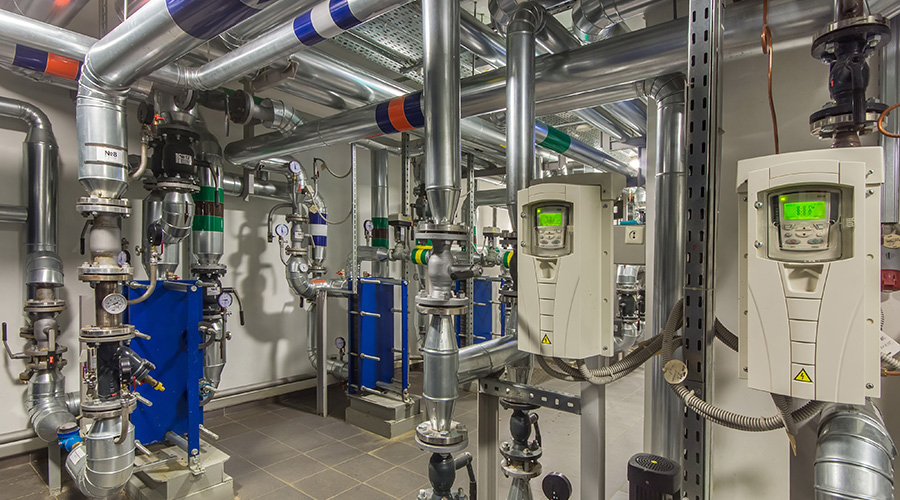Motor Maintenance Matters
Ensuring that motors perform reliably and cost-effectively requires a comprehensive testing and inspection program
The electric motor is an essential element in many systems supporting facilities operations. Failures of electric motors in those systems can lead to inconvenienced building occupants, prolonged outages of services, and damage to the building and its contents. So it is fortunate that most electric motors have a long, trouble-free service life, requiring only minimum maintenance to keep them operating.
But while a typical building electric motor might be a low-maintenance item, it still requires regular maintenance if it is to achieve the longest possible service life. The fact that most motors do not reach their design life is an indication that few organizations are properly maintaining their inventory of motors.
Establishing a motor maintenance program starts with an understanding of the causes of motor failure and the steps that can be taken to reduce their impact. It includes a program of regular inspections and maintenance activities, designed to keep motors running efficiently. And it includes predictive maintenance activities to help identify and correct small deficiencies before they cause costly motor failures.
Causes of Failures
Most motor failures can be attributed to five factors; heat, dirt, moisture, vibrations, and voltage irregularities. By focusing on eliminating or reducing a motor’s exposure to these factors, a maintenance program can significantly reduce the rate at which motors fail, in the long run reducing maintenance costs and limiting interruptions for building occupants.
Heat. Heat is the most common cause of motor failure before reaching rated service life. Every increase of 10 degrees Centigrade of a motor’s windings above its design operating temperature cuts the life of the motor’s winding insulation by 50 percent, even if the overheating was only temporary.
Overheating arises from a number of factors. If a motor is undersized for an application, or if a manager selects a motor with the wrong starting current and torque characteristics, it will operate warmer than its design temperature. Managers should always match all motors to their connected loads. While undersizing leads to overheating, oversizing lowers the application’s energy efficiency.
Another common cause of overheating is operating the motor in an environment with a high ambient temperature, which reduces the rate at which heat can be conducted from the motor. This condition results in higher-than-rated winding temperatures and shortened service lives. Locating motors in inadequately ventilated areas or close to heat-producing equipment can easily result in ambient temperatures high enough to cause damage. Technicians should monitor the temperature in areas where motors are installed, adding forced ventilation if temperatures exceed the ratings for a motor.
Even if the ambient temperature is within the manufacturer’s guidelines, plugged air passages, blocked cooling fans, and dirty cooling vanes will result in elevated motor operating temperatures. Managers should make sure technicians inspect motors at least annually to ensure that their cooling components are clear.
Dirt. Dirt is particularly damaging to mechanical and electrical motor components. It can accumulate on the surface of a motor, blocking its cooling vanes and fan, raising its operating temperature. Or it can be drawn into the motor, where it abrades insulation, shafts and bearings. If dirt settles on a motor’s windings, it can imbed itself into the winding insulation, reducing its insulating value and leading to possible insulation failure.
Unfortunately, the environment in which most building motors must operate, such as in mechanical rooms, is rather dirty. Cleanliness in areas that are not generally accessed by building occupants traditionally has been a low priority. But if motors are expected to perform over their rated service lives, then areas housing motors must be kept as clean as possible. Besides keeping debris from accumulating on floors and equipment, managers should make sure air intakes to these areas are screened and filtered if possible. If an area is exposed to high levels of dirt that cannot be controlled, motors should be protected with shielding devices.
Moisture. Like dirt, moisture attacks both the mechanical and electrical components in a motor. It corrodes the shafts, bearings, rotors, stator laminations and housings. It can penetrate the insulation of a motor’s windings, leading to insulation failure.
While moisture is detrimental to the service life of any motor, it is particularly damaging in applications where a motor serves in a standby mode or is used seasonally. Unlike applications where motors operate continuously, intermittent applications might not generate sufficient heat within the motor to drive off the moisture.
Technicians should inspect all motor installations to ensure they are dry. If humidity levels are high, managers should consider using forced ventilation or mechanical dehumidification.
Vibration. Vibration in motors and the loads they drive can have a range of causes, some within the motor itself and some within the load that it drives. Vibration can result from:
- misalignment of the motor and load, which can cause shafts and couplings to flex and vibrate
- loose motor or load mountings
- unbalanced motor or load components
- worn bearings, which can allow shafts to move off center
- the accumulation of corrosion, grease or other debris on rotating components.
Over time, vibrations can destroy a motor’s bearings or result in the formation of fatigue cracks in the insulation on the motor’s windings.
Technicians should check motor alignment annually. Whenever they service a motor or its load, they should check it for proper balance. Once each year, they also should check motor- and load-mounting bolts for proper tightness. Each time they inspect a motor, they should be sure it is free from the accumulation of debris on rotating surfaces.
Voltage irregularities. While managers and technicians focus much of their attention on physical conditions that cause motor failure, they often overlook the quality and condition of the power source driving the motor. Any variation in the power beyond the level at which a motor is designed to operate can prove to be deadly to the motor. Undervoltage and overvoltage conditions cause rapid heating in the windings, shortening their life. Voltage spikes caused by lightning strikes and power switching can trigger failures in the winding insulation. And harmonics introduced by equipment located elsewhere in the facility can contribute to overheating of the windings.
For three phase-motors, an even more serious condition results from unbalanced voltage conditions. Even minor variations in voltages between phases will result in increased current flow and overheating of the motor’s windings.
Once each year, technicians should check the voltage and current to all motors. If they suspect power problems, managers should consider installing monitoring equipment that can detect voltage spikes and system harmonics. Both conditions are best eliminated at their source, rather than at the motor. If they cannot be eliminated, technicians will have to add protective devices.
Motor Maintenance
Maintenance programs for electric motors must start with an inventory of motors installed in a facility. But the inventory should go beyond just a simple listing of motors installed, their locations and the loads they power. The inventory also must examine the characteristics of the application as a way of determining if a motor that is installed is the correct type and rating for that application. If a motor and load are mismatched, even the most thorough maintenance program will not be able to prevent motor failures.
Given the number of motors found in most facilities, managers will have to prioritize the inventory. It is doubtful that any facility would have the resources required to implement a comprehensive maintenance program on all its motors. Instead, managers should identify motors that, if they failed, would create a threat to the safety and security of a facility and its occupants, a major disruption to operations, or a significant economic loss to facility owners.
At a minimum, managers should implement routine and preventive measures for those motors. Annual inspections, record keeping, vibration testing, cleaning, voltage and current readings, and lubrication all will help to keep a motor operating. But preventive measures alone cannot prevent or even minimize motor failures. Motors still will fail, seemingly without warning.
Motors, however, do give warnings of impending failures that technicians can identify by using several predictive maintenance procedures, including insulation resistance testing, polarized index testing, and DC high-potential testing. By tracking the results of these tests over time, technicians can identify trends of deterioration.
The insulation resistance test is one of the oldest predictive tests used to evaluate the condition of a motor’s insulation. A megohmmeter applies a DC voltage, typically 500 to 2,500 volts, to a motor’s windings and gives a readout of the resistance of the insulation. Since the test is highly sensitive to moisture and temperature, technicians should perform all testing when the motor is at ambient temperature and humidity levels are relatively low.
Polarized insulation testing also reports on the condition of motor’s insulation, but it takes into account that insulation molecules polarize as they are tested, changing the test results. Where insulation resistance testing is rather short in duration, polarized insulation testing is performed over a 10-minute interval, with readings taken and 1 and 10 minutes.
The value taken during the reading at the 10-minute interval then is divided by the reading taken at the 1-minute interval to determine the polarization index. Insulation that is in good condition will yield indexes above one and will not change from one test year to the next. Falling values indicates that insulation is in the process of failing.
Finally, technicians can use DC high-potential testing to detect weaknesses in the insulation that generally are missed by both insulation resistance and polarized insulation testing. The test provides information on the dielectric strength of the insulation and can identify areas within a motor’s insulation that are likely to fault to ground.
Related Topics:











